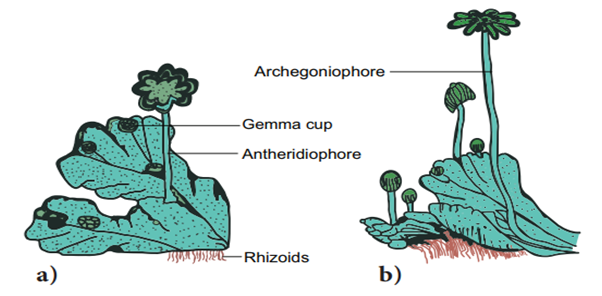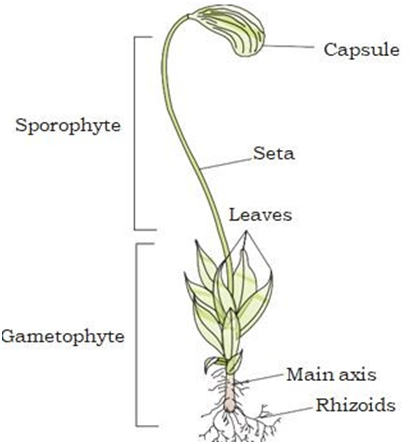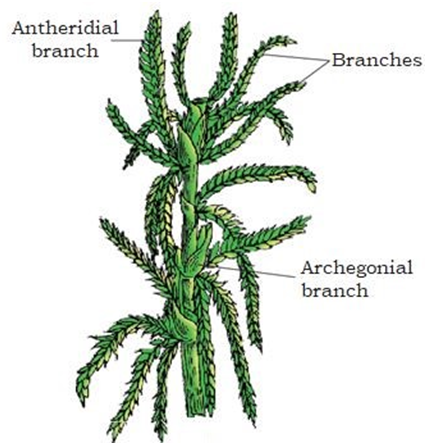Bryophytes
Mosses, liverworts, and hornworts are all classified as bryophytes. They are non-vascular plants, meaning they do not have roots or vascular tissue and instead take water and nutrients from the air through their surface. It has a variety of mosses and liverworts that are usually found growing in wet shaded regions in the hills. Bryophytes are also known as amphibians of the plant kingdom since they can live in soil but need water to reproduce sexually. They prefer moist, humid, and shady environments. On bare rocks/soil, they serve a crucial role in plant succession.Bryophytes' plant bodies are more distinct than algae's. It is thallus-like, prostrate or upright, and has unicellular or multicellular rhizoids that connect to the substratum. They are devoid of genuine roots, stems, and leaves. They may have structures that resemble roots, leaves, or stems. The bryophyte's primary plant body is haploid. It is called a gametophyte because it generates gametes. Bryophytes have multicellular sex organs. The male sex organ is referred to as the antheridium. Biflagellate antherozoids are produced by them. Archegonium, the female sex organ, is flask-shaped and produces a single egg. The antherozoids are discharged into the water, where archegonium is present. The zygote is formed when an antherozoid unites with the egg. Zygotes do not go through reduction division immediately.
They generate a sporophyte, which is a multicellular body. The sporophyte is not a free-living organism; it is linked to the photosynthetic gametophyte and feeds on it. To form haploid spores, some sporophyte cells undergo reduction division (meiosis). The gametophyte is produced when these spores germinate.
Bryophytes are not economically important in general, although some mosses supply food for herbivorous mammals, birds, and other creatures. Because of their ability to hold water, Sphagnum moss species have traditionally been utilized as fuel and as packing material for the trans-shipment of living material. Mosses and lichens were the first creatures to inhabit rocks and are hence extremely important ecologically. They break down rocks, allowing higher plants to thrive on the substrate. Mosses decrease the impact of pouring rain and prevent soil erosion by forming dense mats on the soil. Liverworts and mosses are two types of bryophytes.
A. Liverworts: Land plants with no circulatory system are known as liverworts. The liverworts like moist, shaded environments such as stream banks, marshy terrain, damp soil, tree bark, and deep in the forests. The plant body of a liverwort, such as Marchantia, is a thalloid. The thallus is dorsiventral and adheres to the substrate tightly. On the stem-like structures of the leafy members, there are two rows of small leaf-like appendages. In liverworts, asexual reproduction occurs by the fragmentation of thalli or the creation of specialized structures known as gemmae (sing. gemma). Gemmae are asexual, multicellular green buds that grow in little receptacles on the thalli called gemma cups. The gemmae separate from the parent body and germinate, resulting in the formation of new individuals.Male and female sex organs are generated on the same or distinct thalli during sexual reproduction. The sporophyte has three parts: a foot, a seta, and a capsule. Within the capsule, spores are formed after meiosis. These spores become free-living gametophytes when they germinate.

Figure 4: Marchantia (a) Male Thallus. (b) Female Thallus.
B. Mosses: The gametophyte, which has two stages, is the most important stage in a moss' life cycle. The protonema stage, which arises immediately from a spore, is the first stage. It takes the form of a creeping, green, branching, and filamentous stage. The second stage is the leafy stage, which grows as a lateral bud from the secondary protonema. They are made composed of thin, erect axes with spirally arranged leaves. They are linked to the soil by rhizoids, which are multicellular and branching. The sex organs are carried at this stage. Mosses reproduce vegetatively by fragmentation and budding in their secondary protonema. The sex organs antheridia and archegonia are generated at the top of the leafy branches during sexual reproduction.The zygote grows into a sporophyte, which has a foot, seta, and capsule after fertilization. Moss sporophytes are more complex than liverwort sporophytes. There are spores in the capsule. After meiosis, spores are generated. Mosses have a complex system for dispersing their spores. Mosses such as Funaria, Polytrichum, and Sphagnum are common examples.



 ACME SMART PUBLICATION
ACME SMART PUBLICATION
